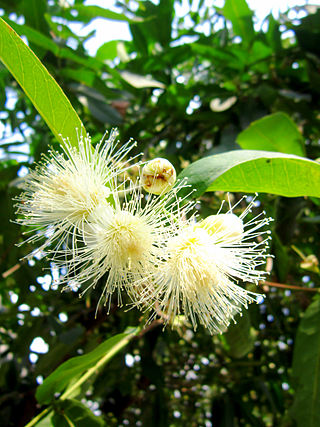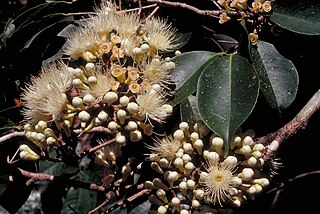
Syzygium samarangense is a species of flowering plant in the family Myrtaceae, native to an area that includes the Greater Sunda Islands, Malay Peninsula, and the Andaman and Nicobar Islands, but introduced in prehistoric times to a wider area and now widely cultivated in the tropics. Common names in English include wax apple, Java apple, Semarang rose-apple, and wax jambu.

Syzygium is a genus of flowering plants that belongs to the myrtle family, Myrtaceae. The genus comprises about 1200 species, and has a native range that extends from Africa and Madagascar through southern Asia east through the Pacific. Its highest levels of diversity occur from Malaysia to northeastern Australia, where many species are very poorly known and many more have not been described taxonomically. One indication of this diversity is in leaf size, ranging from as little as a half inch to as great as 4 ft 11 inches by sixteen inches in Syzygium acre of New Caledonia.

Syzygium cumini, commonly known as Malabar plum, Java plum, black plum, jamun, jaman, jambul, or jambolan, is an evergreen tropical tree in the flowering plant family Myrtaceae, and favored for its fruit, timber, and ornamental value. It is native to the Indian subcontinent and Southeast Asia, including Myanmar, Sri Lanka, Bangladesh and the Andaman Islands. It can reach heights of up to 30 metres (98 ft) and can live more than 100 years. A rapidly growing plant, it is considered an invasive species in many world regions.

Syzygium jambos is a species of rose apple originating in Southeast Asia and occurring widely elsewhere, having been introduced as an ornamental and fruit tree.

Syzygium malaccense is a species of flowering tree native to tropical Asia and Australia. It is one of the species cultivated since prehistoric times by the Austronesian peoples. They were carried and introduced deliberately to Remote Oceania as canoe plants. In modern times, it has been introduced throughout the tropics, including many Caribbean countries and territories.
Syzygium beddomei is a species of plant in the family Myrtaceae. It is endemic to Tamil Nadu in India.

Syzygium bourdillonii is a species of plant in the family Myrtaceae. It is endemic to Kerala in India. It is threatened by habitat loss.
Syzygium courtallense is a species of plant in the family Myrtaceae. It is endemic to India. It is threatened by habitat loss.

Syzygium densiflorum is a species of evergreen tree in the family Myrtaceae. It is endemic to the Western Ghats mountains, India. The species is categorised as Vulnerable in the IUCN Red List.
Syzygium microphyllum is a species of plant in the family Myrtaceae. It is endemic to India. It is threatened by habitat loss. In 1998 the now disputed taxon Syzygium gambleanum was listed as extinct in the IUCN Red List. However, after research work by the Royal Botanic Gardens Kew this plant was revealed as identical with Syzygium microphyllum and so the name Syzygium gambleanum became an illegitimate synonym.
Syzygium neesianum is a species of plant in the family Myrtaceae. It is endemic to Sri Lanka.
Syzygium palghatense is a species of plant in the family Myrtaceae. It is endemic to India. It is threatened by habitat loss. It has been discovered in large numbers in Bhrahmagiri hills near Karnataka in 2014.
Syzygium cordifolium is a species of plant in the family Myrtaceae. It is endemic to Sri Lanka.

Syzygium stocksii is a species of plant in the family Myrtaceae. It is endemic to India.

Syzygium guineense is a leafy forest tree of the family Myrtaceae, found in many parts of Africa both wild and domesticated. Both its fruits and leaves are edible; the pulp and the fruit skin are sucked and the seed discarded. It is sometimes called "waterberry", but this may also refer to other species of Syzygium.

Syzygium nervosum is a species of tree native to tropical Asia and Australia, extending as far north as Guangdong and Guangxi in China and as far south as the Northern Territory of Australia. It was previously known as Cleistocalyx operculatus and also known as C. nervosum(DC.) Kosterm., and Eugenia operculataRoxb., 1832. It is a medium-sized tree of about 10 meters in height with pale brown bark and dull green leaves.

Syzygium klampok, the klampok, is a species of flowering plant in the family Myrtaceae. It is endemic to Java, Indonesia, where it is endangered. Due to its association with springs, it is considered a sacred tree.
Syzygium nidie is a species of flowering plant in the family Myrtaceae, native to Vanuatu and Fiji. A hardwood tree reaching 15 m (50 ft), it is harvested commercially for its timber.

Syzygium sayeri, commonly known as pink satinash, is a plant in the family Myrtaceae which is native to northeastern Queensland, Australia, and New Guinea.
Syzygium dubium is a species of flowering plant in the myrtle family, Myrtaceae. It is a tree endemic to the island of Vanua Levu in Fiji, where it is known from the Wainunu catchment.












